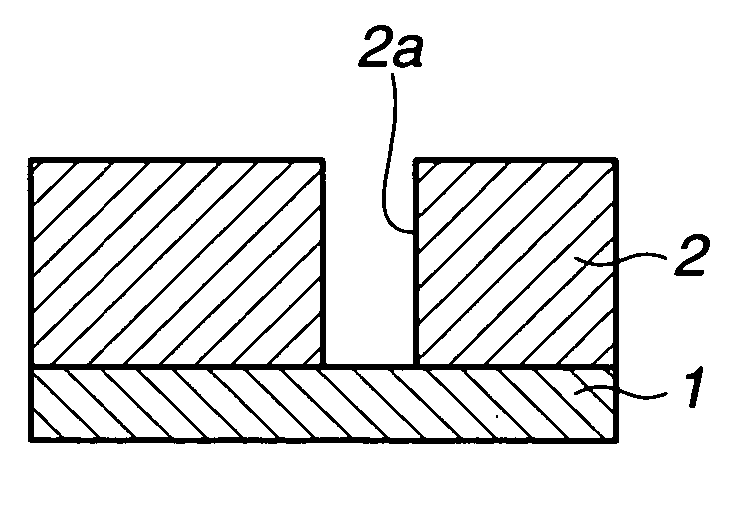Porous film-forming composition, patterning process, and porous sacrificial film
a technology of porous film and composition, applied in the field of porous film-forming composition, patterning process, and porous sacrificial film, can solve the problems of tapered resist pattern shape, insufficient precision of achromatic lenses or aspherical catoptric systems, and approaching the essential limit of resolution determined by light source wavelength
- Summary
- Abstract
- Description
- Claims
- Application Information
AI Technical Summary
Benefits of technology
Problems solved by technology
Method used
Image
Examples
preparation example 1
[0147] A 5-liter flask was charged with 1,135 g of ultrapure water, 1,135 g of ethanol and 83 g of a 10% TMAH aqueous solution. In a nitrogen atmosphere and at 30° C., a mixture of 51 g of methyltrimethoxysilane, 78 g of tetraethoxysilane, 24 g of phenyltrimethoxysilane, and 54 g of 3,4-epoxycyclohexyl-ethyltrimethoxysilane was added and thoroughly mixed. After one hour, 5.5 g of acetic acid and then 880 g of PGMEA were added to the reaction solution, from which ethanol and methanol were distilled off in a vacuum of 100 hPa. To the residue was added 600 g of ethyl acetate. The water layer was separated off, and the organic layer was washed with 600 g of ultrapure water, which procedure was repeated three times. To the organic layer was added 1,200 g of PnP. This solution was concentrated in a vacuum of 20 hPa, yielding 1,000 g of Polymer 1 solution. The nonvolatile content was 11.0 wt %.
preparation example 2
[0148] A 5-liter flask was charged with 1,135 g of ultrapure water, 1,135 g of ethanol and 83 g of a 10% TMAH aqueous solution. In a nitrogen atmosphere and at 30° C., a mixture of 51 g of methyltrimethoxysilane, 79 g of tetraethoxysilane, 24 g of phenyltrimethoxysilane, and 52 g of glycidoxypropyl-trimethoxysilane was added and thoroughly mixed. After one hour, 5.5 g of acetic acid and then 880 g of PGMEA were added to the reaction solution, from which ethanol and methanol were distilled off in a vacuum of 100 hPa. To the residue was added 600 g of ethyl acetate. The water layer was separated off, and the organic layer was washed with 600 g of ultrapure water, which procedure was repeated three times. To the organic layer was added 1,200 g of PnP. This solution was concentrated in a vacuum of 20 hPa, yielding 950 g of Polymer 2 solution. The nonvolatile content was 10.5 wt %.
preparation example 3
[0149] A 5-liter flask was charged with 1,135 g of ultrapure water, 1,135 g of ethanol and 83 g of a 10% TMAH aqueous solution. In a nitrogen atmosphere and at 30° C., a mixture of 165 g of tetraethoxysilane, 24 g of phenyltrimethoxysilane, and 54 g of glycidoxypropyltrimethoxysilane was added and thoroughly mixed. After one hour, 5.5 g of acetic acid and then 880 g of PGMEA were added to the reaction solution, from which ethanol and methanol were distilled off in a vacuum of 100 hPa. To the residue was added 600 g of ethyl acetate. The water layer was separated off, and the organic layer was washed with 600 g of ultrapure water, which procedure was repeated three times. To the organic layer was added 1,200 g of PnP. This solution was concentrated in a vacuum of 20 hPa, yielding 1,000 g of Polymer 3 solution. The nonvolatile content was 9.5 wt %.
PUM
| Property | Measurement | Unit |
|---|---|---|
| wavelength | aaaaa | aaaaa |
| size | aaaaa | aaaaa |
| refractive index | aaaaa | aaaaa |
Abstract
Description
Claims
Application Information
 Login to View More
Login to View More - R&D
- Intellectual Property
- Life Sciences
- Materials
- Tech Scout
- Unparalleled Data Quality
- Higher Quality Content
- 60% Fewer Hallucinations
Browse by: Latest US Patents, China's latest patents, Technical Efficacy Thesaurus, Application Domain, Technology Topic, Popular Technical Reports.
© 2025 PatSnap. All rights reserved.Legal|Privacy policy|Modern Slavery Act Transparency Statement|Sitemap|About US| Contact US: help@patsnap.com



